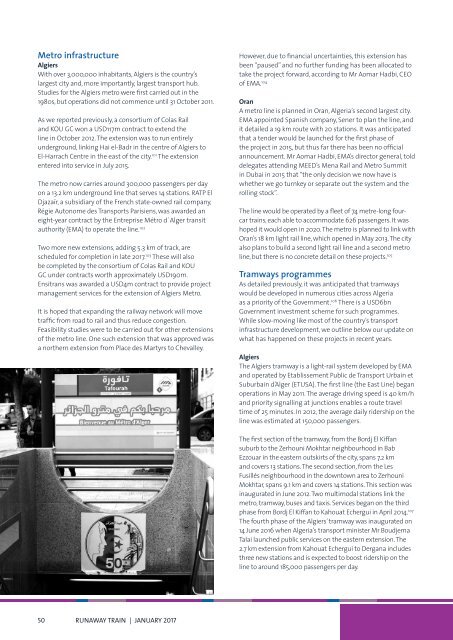Runaway Train
2jdqSdB
2jdqSdB
You also want an ePaper? Increase the reach of your titles
YUMPU automatically turns print PDFs into web optimized ePapers that Google loves.
Metro infrastructure<br />
Algiers<br />
With over 3,000,000 inhabitants, Algiers is the country’s<br />
largest city and, more importantly, largest transport hub.<br />
Studies for the Algiers metro were first carried out in the<br />
1980s, but operations did not commence until 31 October 2011.<br />
As we reported previously, a consortium of Colas Rail<br />
and KOU GC won a USD117m contract to extend the<br />
line in October 2012. The extension was to run entirely<br />
underground, linking Hai el-Badr in the centre of Algiers to<br />
El-Harrach Centre in the east of the city. 101 The extension<br />
entered into service in July 2015.<br />
The metro now carries around 300,000 passengers per day<br />
on a 13.2 km underground line that serves 14 stations. RATP El<br />
Djazaïr, a subsidiary of the French state-owned rail company,<br />
Régie Autonome des Transports Parisiens, was awarded an<br />
eight-year contract by the Entreprise Métro d´Alger transit<br />
authority (EMA) to operate the line. 102<br />
Two more new extensions, adding 5.3 km of track, are<br />
scheduled for completion in late 2017. 103 These will also<br />
be completed by the consortium of Colas Rail and KOU<br />
GC under contracts worth approximately USD190m.<br />
Ensitrans was awarded a USD4m contract to provide project<br />
management services for the extension of Algiers Metro.<br />
It is hoped that expanding the railway network will move<br />
traffic from road to rail and thus reduce congestion.<br />
Feasibility studies were to be carried out for other extensions<br />
of the metro line. One such extension that was approved was<br />
a northern extension from Place des Martyrs to Chevalley.<br />
However, due to financial uncertainties, this extension has<br />
been “paused” and no further funding has been allocated to<br />
take the project forward, according to Mr Aomar Hadbi, CEO<br />
of EMA. 104<br />
Oran<br />
A metro line is planned in Oran, Algeria’s second largest city.<br />
EMA appointed Spanish company, Sener to plan the line, and<br />
it detailed a 19 km route with 20 stations. It was anticipated<br />
that a tender would be launched for the first phase of<br />
the project in 2015, but thus far there has been no official<br />
announcement. Mr Aomar Hadbi, EMA’s director general, told<br />
delegates attending MEED’s Mena Rail and Metro Summit<br />
in Dubai in 2015 that “the only decision we now have is<br />
whether we go turnkey or separate out the system and the<br />
rolling stock”.<br />
The line would be operated by a fleet of 74 metre-long fourcar<br />
trains, each able to accommodate 626 passengers. It was<br />
hoped it would open in 2020. The metro is planned to link with<br />
Oran’s 18 km light rail line, which opened in May 2013. The city<br />
also plans to build a second light rail line and a second metro<br />
line, but there is no concrete detail on these projects. 105<br />
Tramways programmes<br />
As detailed previously, it was anticipated that tramways<br />
would be developed in numerous cities across Algeria<br />
as a priority of the Government. 106 There is a USD6bn<br />
Government investment scheme for such programmes.<br />
While slow-moving like most of the country’s transport<br />
infrastructure development, we outline below our update on<br />
what has happened on these projects in recent years.<br />
Algiers<br />
The Algiers tramway is a light-rail system developed by EMA<br />
and operated by Etablissement Public de Transport Urbain et<br />
Suburbain d’Alger (ETUSA). The first line (the East Line) began<br />
operations in May 2011. The average driving speed is 40 km/h<br />
and priority signalling at junctions enables a route travel<br />
time of 25 minutes. In 2012, the average daily ridership on the<br />
line was estimated at 150,000 passengers.<br />
The first section of the tramway, from the Bordj El Kiffan<br />
suburb to the Zerhouni Mokhtar neighbourhood in Bab<br />
Ezzouar in the eastern outskirts of the city, spans 7.2 km<br />
and covers 13 stations. The second section, from the Les<br />
Fusillés neighbourhood in the downtown area to Zerhouni<br />
Mokhtar, spans 9.1 km and covers 14 stations. This section was<br />
inaugurated in June 2012. Two multimodal stations link the<br />
metro, tramway, buses and taxis. Services began on the third<br />
phase from Bordj El Kiffan to Kahouat Echergui in April 2014. 107<br />
The fourth phase of the Algiers’ tramway was inaugurated on<br />
14 June 2016 when Algeria’s transport minister Mr Boudjema<br />
Talai launched public services on the eastern extension. The<br />
2.7 km extension from Kahouat Echergui to Dergana includes<br />
three new stations and is expected to boost ridership on the<br />
line to around 185,000 passengers per day.<br />
50 <strong>Runaway</strong> train | January 2017


